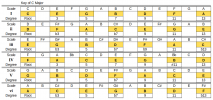Steve_Sawyer
Blues Newbie
Didn't want to keep Griff hanging around too late on yesterday's session, but I was a little confused still re "tall" chords.
From the research I did today, it appears that I found the answer to my basic question.
For 7th chords, whether the 7th is major or minor (7th or b7), like the 3rd, will vary depending on what chord we're talking about - i.e. I, IV chords will use a major 7th, and ii, iii, V and vi chords will employ a minor 7th (b7). However, for 9th, 11th and 13th chords, those degrees seem to remain constant. It doesn't matter whether you're building a I9 or a vi9 (major or minor chord), the 9th is always the 9th degree of the chord root, never "flatted" or "sharped". Same for the 11th and 13th. So - do I have that right?
However, it appears that while building a "tall" chord beyond the 7th, the 9th, 11th and 13th are always accompanied by a b7, not a Maj7. This raises the question what the rules are for using such "tall" chords - should they not be used over a I or IV chord which are normally Maj7 not Min7? I'm confused here (yeah, nothing new! )
)
From the research I did today, it appears that I found the answer to my basic question.
For 7th chords, whether the 7th is major or minor (7th or b7), like the 3rd, will vary depending on what chord we're talking about - i.e. I, IV chords will use a major 7th, and ii, iii, V and vi chords will employ a minor 7th (b7). However, for 9th, 11th and 13th chords, those degrees seem to remain constant. It doesn't matter whether you're building a I9 or a vi9 (major or minor chord), the 9th is always the 9th degree of the chord root, never "flatted" or "sharped". Same for the 11th and 13th. So - do I have that right?
However, it appears that while building a "tall" chord beyond the 7th, the 9th, 11th and 13th are always accompanied by a b7, not a Maj7. This raises the question what the rules are for using such "tall" chords - should they not be used over a I or IV chord which are normally Maj7 not Min7? I'm confused here (yeah, nothing new!


